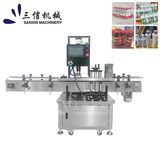Quality Automatic Capping: Techniques to Boost Operational Efficiency
May 08,2025

Quality Automatic Capping: Techniques to Boost Operational Efficiency
Table of Contents
- 1. Introduction to Quality Automatic Capping
- 2. The Importance of Efficient Capping in Manufacturing
- 3. Types of Automatic Capping Machines
- 4. Techniques to Improve Operational Efficiency
- 5. Quality Control in Automatic Capping
- 6. Common Challenges in Automatic Capping
- 7. Technological Advancements in Capping Machines
- 8. The Future of Automatic Capping in Manufacturing
- 9. Frequently Asked Questions
- 10. Conclusion
1. Introduction to Quality Automatic Capping
Quality automatic capping plays a pivotal role in the manufacturing and packaging industries, ensuring that products are sealed securely and efficiently. As companies strive to increase productivity while maintaining high standards, understanding the nuances of automatic capping becomes essential. This article delves into techniques that enhance operational efficiency, exploring the significance of quality capping and the latest innovations that support these objectives.
2. The Importance of Efficient Capping in Manufacturing
Capping is more than just a sealing process; it is a critical stage that preserves product integrity. Efficient capping can profoundly impact various aspects of production:
2.1. Ensures Product Safety
A reliable capping process prevents contamination and spillage, safeguarding product quality and safety for consumers.
2.2. Enhances Brand Reputation
Inconsistent sealing can lead to product recalls and damaged reputation. High-quality capping fosters consumer trust and satisfaction.
2.3. Reduces Waste and Costs
Efficient capping minimizes product loss and reduces the need for rework, ultimately saving resources and costs.
3. Types of Automatic Capping Machines
Understanding the different types of automatic capping machines can help manufacturers select the right solution for their needs.
3.1. Screw Capping Machines
These machines use a rotary head to apply screw caps, ensuring a tight seal suitable for various container types.
3.2. Snap or Press-On Capping Machines
Ideal for caps that require a simple push to seal, these machines are commonly used in the beverage industry.
3.3. Induction Sealing Machines
Utilizing electromagnetic induction, this method provides a tamper-evident seal, enhancing product security.
3.4. Specialty Capping Equipment
Designed for unique applications, these machines cater to specific industries and product requirements.
4. Techniques to Improve Operational Efficiency
To boost operational efficiency in capping processes, manufacturers can implement the following techniques:
4.1. Automation of the Capping Process
Integrating automated systems can significantly enhance speed and precision, reducing labor costs and minimizing human error.
4.2. Regular Maintenance and Calibration
Frequent maintenance ensures that machines operate at peak performance, preventing downtime and production delays. Calibration is crucial to maintain accuracy.
4.3. Employee Training and Development
Investing in training ensures that employees are well-versed in operating capping machines, troubleshooting common issues and maintaining quality standards.
4.4. Implementing Lean Manufacturing Principles
Applying lean principles helps identify waste and improve processes, ensuring that capping operations are efficient and streamlined.
4.5. Utilizing Advanced Monitoring Systems
Incorporating real-time monitoring technology can help track performance metrics, allowing for quick adjustments to optimize production.
5. Quality Control in Automatic Capping
Quality control is essential to maintain the integrity of the capping process.
5.1. Visual Inspections
Regular visual inspections can identify issues with sealing, ensuring that quality is upheld before products reach consumers.
5.2. Automated Quality Testing Systems
Advanced testing systems can detect defective seals and initiate corrective actions immediately, maintaining high quality standards.
5.3. Data Analysis for Continuous Improvement
Collecting and analyzing data from capping operations can reveal insights, leading to ongoing improvements in quality and efficiency.
6. Common Challenges in Automatic Capping
Manufacturers often face several challenges in automatic capping processes:
6.1. Variability in Container Shape and Size
Different container designs can affect capping efficiency and consistency. Utilizing adaptable machinery can mitigate these issues.
6.2. Cap Misalignment
Misalignment can lead to faulty seals. Regular checks and adjustments can help maintain proper cap placement.
6.3. Equipment Downtime
Unexpected machine failures can halt production. Implementing a robust maintenance schedule can minimize these occurrences.
7. Technological Advancements in Capping Machines
The packaging industry is continuously evolving, with new technologies enhancing capping processes.
7.1. Smart Capping Machines
These machines utilize AI and machine learning to adapt capping processes in real-time, improving efficiency.
7.2. Enhanced Safety Features
Modern capping machines come equipped with advanced safety features, ensuring operator protection and minimizing risks.
7.3. Eco-Friendly Solutions
Sustainability is a growing trend, with manufacturers exploring biodegradable caps and energy-efficient machines.
8. The Future of Automatic Capping in Manufacturing
As industry demands evolve, the future of automatic capping will be shaped by several factors:
8.1. Increased Customization
The trend toward personalized packaging will necessitate more adaptable capping solutions.
8.2. Integration of Smart Technologies
The Internet of Things (IoT) will play a critical role in connecting capping machines, enabling real-time data sharing and performance tracking.
8.3. Focus on Environmental Sustainability
Manufacturers will increasingly prioritize eco-friendly practices, leading to innovations in materials and processes.
9. Frequently Asked Questions
9.1. What is automatic capping?
Automatic capping is a process that utilizes machines to apply caps to containers efficiently and consistently, ensuring a secure seal.
9.2. How can I improve my capping process?
Improving your capping process can be achieved through automation, regular maintenance, employee training, and adopting lean manufacturing principles.
9.3. What types of capping machines are available?
Common types include screw capping machines, snap capping machines, induction sealing machines, and specialty capping equipment.
9.4. Why is quality control important in capping?
Quality control is crucial to ensure that products are sealed correctly, maintaining safety and preventing potential recalls.
9.5. What are the latest trends in capping technology?
Recent trends include smart capping machines, enhanced safety features, and a focus on eco-friendly solutions.
10. Conclusion
Quality automatic capping is an indispensable component of the manufacturing and packaging industries. By implementing effective techniques and embracing technological advancements, manufacturers can significantly boost operational efficiency. As we move forward, the integration of smart technology and sustainable practices will shape the future of capping, ensuring that companies remain competitive and capable of meeting evolving consumer demands. Investing in quality capping solutions is not merely an operational choice; it’s a strategic necessity for success in today’s dynamic market.
Latest News
Guangzhou Sanxin Machinery Co., Ltd. to Showcase Innovative Equipment at COSMOPACK ASIA 2025
Guangzhou Sanxin Machinery Co., Ltd., a prominent manufacturer specializing in advanced machinery for the beauty and cosmetics industry, is thrilled to announce its participation in COSMOPACK ASIA 2025.
Nov 11,2025
Guangzhou Sanxin Machinery Co., Ltd. to Showcase Advanced Packaging Solutions at CIBE 2025
Guangzhou Sanxin Machinery Co., Ltd. to Showcase Advanced Packaging Solutions at CIBE 2025
Sep 01,2025
Discover Cutting-Edge Packaging Solutions at Booth B39
Discover Cutting-Edge Packaging Solutions at Booth B39
Jul 11,2025











